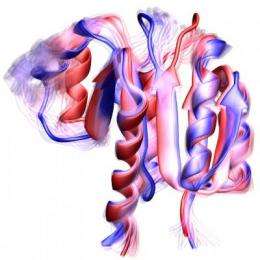Reaching the summit of protein dynamics

Understanding the incredibly speedy atomic mechanisms at work when a protein transitions from one shape to another has been an elusive scientific goal for years, but an essential one for elucidating the full panoply of protein function. How do proteins transition, or interconvert, between distinct shapes without unfolding in the process? Until now, this question has been a hypothetical one, approached by computation only rather than experimentation.
In a groundbreaking study this week in Cell, Brandeis researchers reveal for the first time computationally and experimentally the molecular pathway that a protein takes to cross the energy barrier, the "climb over the mountain." The study reports how folded proteins can efficiently change shape while avoiding unfolding, a critical requirement for any protein in the cell.
Using computation and nuclear magnetic resonance (NMR) spectroscopy, the researchers were able to experimentally measure how fast the signaling nitrogen regulatory protein jumps from one shape to another, and to shed light into the atomistic pathway.
"If you think of crossing the energy barrier as reaching the summit of a mountain, what we revealed is the molecular "hiking" path the protein follows from a deep valley, to the area around the summit, and then back into another not quite-as-deep valley," said Brandeis biophysicist and Howard Hughes Medical Institute (HHMI) Investigator Dorothee Kern.
Historically, scientists had proposed that proteins must break apart, or partially unfold, between distinct active shapes. "That never made sense to me," said Kern, "because if you break the shape of the protein, you have to build it new again and that is too complicated and energy-inefficient; it would take too long."
Kern said they discovered that the signaling protein unfolds on the minute timescale, once every five minutes, while interconversion between the functionally active states happens on the microsecond timescale (10,000 times per second).
First computationally and then experimentally, Kern and her colleagues showed that the protein actually never unfolds on the way, but rather goes through transient, or bridging, states that last less than a nanosecond. The proof? In the transient states, hydrogen bonds, which do not exist in the protein's ground states (the valleys), enable function while circumventing the risk of unfolding.
"This is a proof of principle paper; it changes the paradigm of protein dynamics because these transient nonnative atomic interactions were really hidden before," said Kern. "This paper underscores the need to develop an iterative approach between computation and experimentation."
Understanding protein dynamics is essential to improving protein design for all kinds of applications, including engineering, materials science, and pharmaceuticals. "We don't understand how to make proteins change their shape; the missing link is understanding how nature very efficiently and specifically changes the shape of proteins," said Kern. "If we knew the physics of proteins better, it would help us design functional proteins."
Source: Brandeis University (news : web)

















